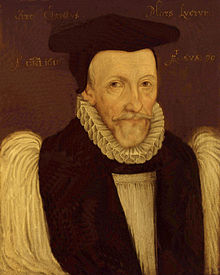| Mary Shelton |
Queen Elizabeth had a reputation for her dislike of marriage and her refusal of permission to many of her ladies in waiting for their proposed marriages. This attitude of the queen often led to her ladies, often relatives of the queen, marrying in secret. When the queen discovered these secret marriages and pregnancies of her ladies, they could be punished by having their titles removed, banishment from court and even imprisonment in the Tower.
| John Scudamore |
In January 1574 Mary Shelton married in secret to John Scudamore (1542-1623). It is likely that the couple were married by a Catholic priest, due to John's faith. Mary became his second wife after his first wife Eleanor Croft had died in 1569, leaving him to raise their five children; Henry (b.1561), John (b.1567), James (b.1568), Ursula (b.1568) and Alice (b.1569).
John was a Catholic, which may have contributed to the fact that Queen Elizabeth disapproved of the match between John and Mary. In 1573 John had asked his father-in-law James Croft to speak to the queen and question whether she would permit him to marry Mary Shelton. The queen refused. It was essential that the queen give permission for Mary's marriage as not only was Queen Elizabeth the head of the Boleyn family, but also Mary was her ward due to both of her parents dying within two weeks of each other in 1558.
It was impossible to hide their marriage from the queen for long, and she found out about it soon after. When the queen found out about their marriage, she was furious and flew into a rage; she hit Mary with a hairbrush which broke one of her fingers. The reason for Mary's broken finger was later blamed on a falling candlestick. Mary was sent away from court, however by October 1574 she was back at court and had been promoted to Lady of the Privy Chamber.
A maid of honour to the queen, Eleanor Brydges, wrote a letter to Edward Manners, Earl of Rutland which mentioned the aftermath of Mary Shelton's marriage.
"the Queen hath used Mary Shelton very ill for her marriage: she hath dealt liberal both with blows and evil words, and hath not yet granted her consent...no one ever bought her husband more dearly"
Mary remained with Queen Elizabeth until the end of her reign, becoming one of her closest friends and favourite sleeping companions. As a result of this, Mary was hardly away from court and very infrequently managed to visit her husbands estates of Holme Lacy in Hertfordshire. However, due to this position Mary became one of the most influential ladies of Queen Elizabeth's court. Mary outlived her queen by only a few months, dying on the 15th August 1603.




